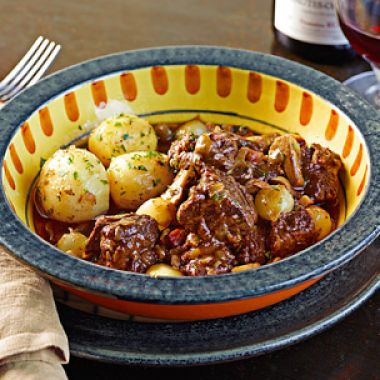Braising

Simmering food slowly in a moderate amount of liquid is a technique known as braising. Relatively tough cuts of meat, such as chuck roast and brisket, and fibrous vegetables, such as carrots, celery and leeks, are excellent candidates for braising. Braising liquid can be water or a more flavorful liquid, such as broth, stock, wine or beer. Onions, garlic, herbs or other ingredients are often added to the liquid for flavoring. Braising and stewing are closely related, although stews are made with more liquid and smaller pieces of food.
Meat to be braised is generally first browned in fat to give it color and add to its flavor. It is then cooked in a relatively small amount of liquid (usually only 1 to 2 inches deep) in a tightly closed pot or baking dish on the top of the stove over medium-low to medium heat or in a moderate (325º to 350ºF) oven. The lid prevents liquid from evaporating, and the food is quickly surrounded by steam.
Braising results in tender, full-flavored dishes that are typically hearty, cold-weather fare. Some favorite braised dishes are pot roast, coq au vin and lamb shanks.
In classic French-style braising, the vegetables that are cooked with the meat or poultry to impart their aromatic flavors are not necessarily served. Instead, fresh vegetables may be added toward the end of cooking for the benefit of their fresher color, texture and flavor.
Adapted from Williams-Sonoma Kitchen Companion: The A to Z Guide to Everyday Cooking, Equipment and Ingredients (Time-Life Books, 2000)